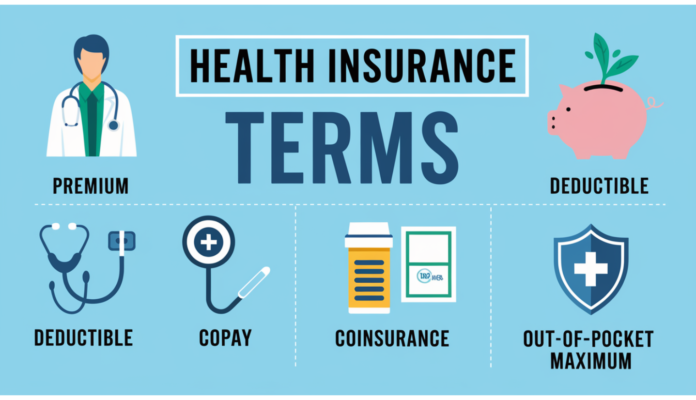Health insurance is essential for covering medical costs, but understanding the language can be challenging. Knowing key terms helps you make better decisions, save on out-of-pocket expenses, and avoid surprises. Here’s a breakdown of the most common health insurance terms and what they mean.
Why Understanding Health Insurance Terms Matters
Understanding health insurance terms helps you:
- Avoid Unexpected Costs: Knowing what terms like “deductible” and “out-of-pocket maximum” mean can prevent unexpected expenses.
- Make Informed Choices: Choosing the right plan requires understanding terms that impact costs, network options, and coverage.
- Communicate Effectively: Whether talking to healthcare providers or the insurance company, understanding key terms makes communication smoother.
Essential Health Insurance Terms to Know
Here are the most important health insurance terms to be familiar with:
- Premium
The premium is the amount you pay each month for your health insurance coverage. Paying premiums on time ensures your coverage remains active. - Deductible
This is the amount you need to pay out-of-pocket before your insurance begins to cover most medical expenses. If your deductible is $1,500, you’ll pay this amount before insurance contributes to costs, except for preventive services covered upfront. - Copay
A copay is a fixed amount you pay for specific healthcare services, such as $20 for a doctor’s visit or $10 for prescription drugs. Copays vary based on the service and your plan. - Coinsurance
Coinsurance is the percentage of costs you pay after reaching your deductible. If your plan covers 80% of a hospital stay, you’re responsible for the remaining 20%. - Out-of-Pocket Maximum
This is the highest amount you’ll pay in a year. After reaching the out-of-pocket maximum, your insurance covers 100% of eligible expenses. - Network
A network is a group of healthcare providers and facilities that partner with an insurance plan. You’ll generally pay less when seeing in-network providers. - Formulary
A formulary is the list of prescription drugs covered by your insurance. Drugs are often grouped by “tiers” based on cost, affecting how much you’ll pay. - Explanation of Benefits (EOB)
After a claim, your insurance will send an EOB detailing what was covered, what wasn’t, and what portion is your responsibility. - Health Savings Account (HSA) and Flexible Spending Account (FSA)
HSAs and FSAs are accounts that let you save pre-tax money for medical expenses. HSAs are linked to high-deductible health plans, while FSAs are more flexible. - Preauthorization
Some plans require preauthorization before receiving certain services. Without it, you might pay more or have the claim denied.
Key Differences Between Common Terms
Some health insurance terms are easily confused. Here’s a quick look at common pairings:
- Deductible vs. Premium: Premiums are paid monthly, while the deductible is a one-time annual amount before coverage starts.
- Copay vs. Coinsurance: Copay is a fixed cost for services; coinsurance is a percentage you pay after the deductible.
- In-Network vs. Out-of-Network: In-network providers are part of the insurance’s network and usually cost less, while out-of-network providers can be significantly more expensive.
Tips for Understanding and Managing Health Insurance Costs
When shopping for health insurance, keep these cost-related terms in mind:
- Premium and Deductible Balance: Plans with lower premiums often come with higher deductibles, which might not be cost-effective if you need frequent care.
- Out-of-Pocket Maximum for Financial Protection: Plans with lower out-of-pocket maximums provide financial protection if you need extensive care.
- Copays and Coinsurance for Routine Expenses: If you plan to use healthcare services regularly, choose a plan with lower copays and coinsurance rates.
How to Use This Knowledge to Choose a Plan
When comparing plans, pay close attention to these terms to choose the best coverage for your needs. Here’s how:
- Estimate Your Healthcare Needs
Think about how often you use medical services. High-deductible plans are good for those with low medical needs, while lower-deductible plans can benefit those with ongoing healthcare expenses. - Evaluate Your Prescription Drug Needs
If you have regular prescriptions, check each plan’s formulary to confirm your medications are covered affordably. - Check the Network
If you have preferred providers, ensure they are in-network with the plans you’re considering. Out-of-network visits can significantly increase your costs. - Consider an HSA or FSA
If you choose a high-deductible plan, consider opening an HSA to save pre-tax money for medical expenses. FSAs are available with other plan types. - Understand the Full Cost of Care
Calculate your potential annual healthcare expenses by combining premiums, deductibles, copays, and coinsurance. This can help you identify the most affordable plan.
Conclusion: Mastering Health Insurance Terminology
Understanding these essential health insurance terms empowers you to make better choices, save money, and avoid unexpected expenses. With this knowledge, you’ll be prepared to confidently navigate your health insurance options and choose a plan that fits your needs.


